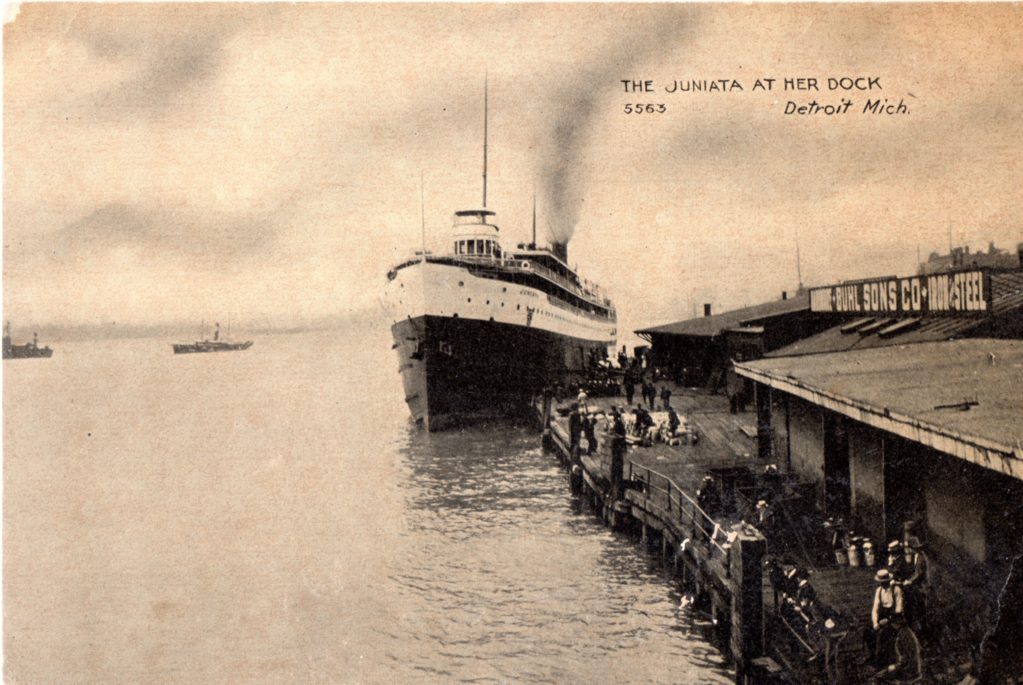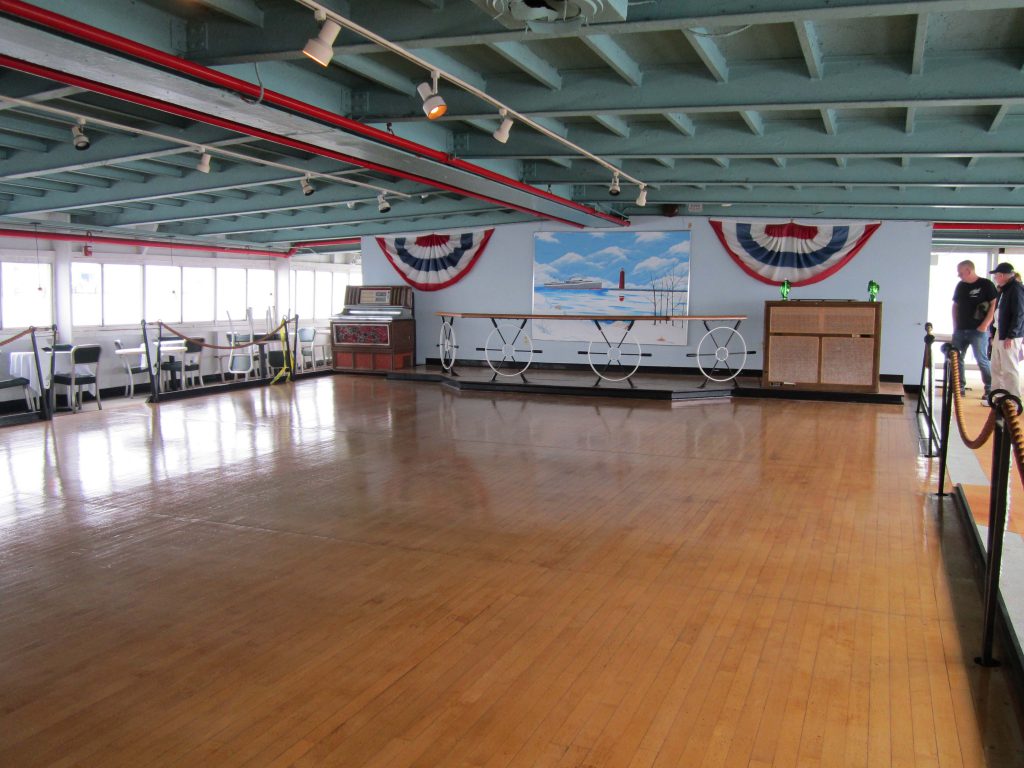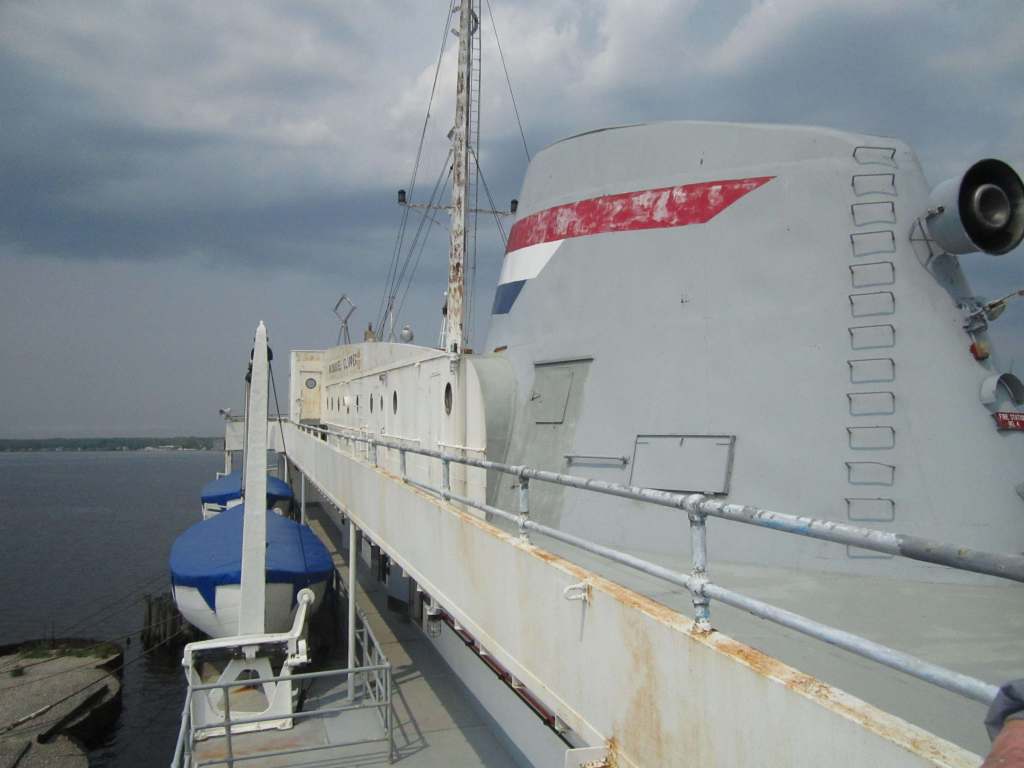The History of the Milwaukee Clipper
Unlike its two sisters ships, the Milwaukee Clipper still survives. You can even tour it.
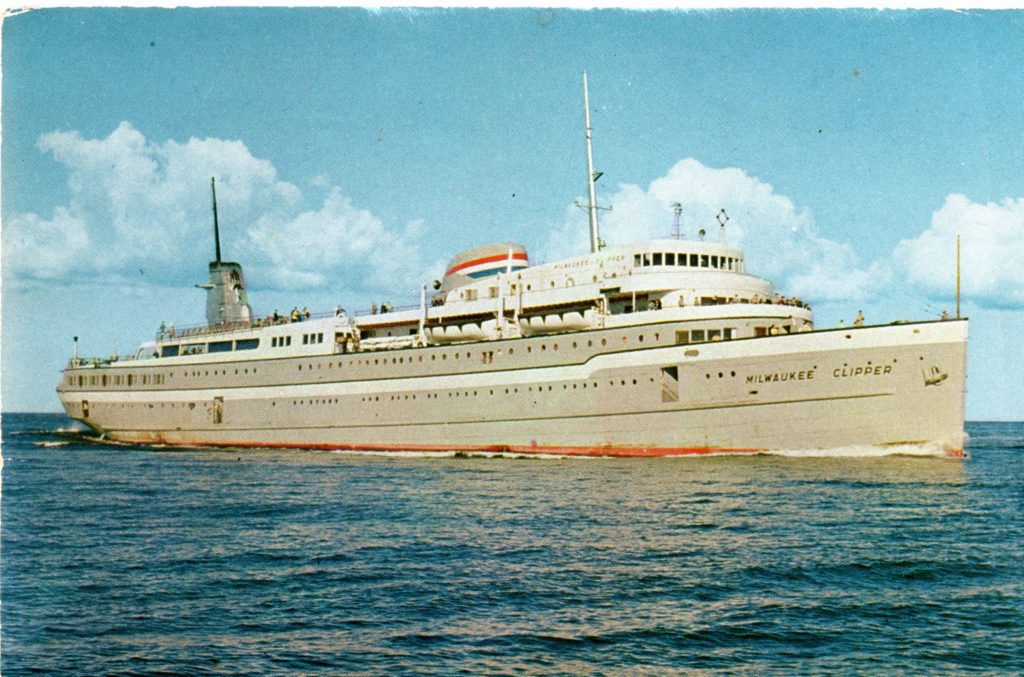
From 1941 to 1970, the Milwaukee Clipper linked Milwaukee and Muskegon, Michigan. The ship offered amenities including a live orchestra, a fine restaurant, and even a movie theatre. Carl Swanson collection
In the early 1900s three elegant sister ships sailed the Great Lakes, the Tionesta, the Juniata, and the Octorara. One of them, renamed the S.S. Milwaukee Clipper, would serve its namesake city from 1941 to 1970.
A lot can happen to a ship in nearly seven decades – and a lot did.
The second of the three nearly identical ships built by the Anchor Line, the Juniata was launched on December 22, 1904, at Cleveland, Ohio. Placed in service between Buffalo, New York, and Duluth, Minnesota, the 361-foot Juniata carried 350 passengers on three decks and 3,500 tons of cargo in its holds. The 3,000 horsepower quadruple-expansion steam engine was an uncommon design and state-of-the-art for its time. It gave the Juniata a top speed of 18 knots – just over 20 miles an hour.
The Juniata’s hull was riveted steel but its passenger decks were made of wood and its elegant staterooms and public areas gleamed with polished oak and mahogany.
In 1934, a minor fire broke out on the four-year-old passenger liner Morro Castle in the Atlantic Ocean. In a startlingly short amount of time, the ship was fully engulfed and 137 passengers and crew members were dead. Stringent safety rules were adopted in the wake of the disaster including a requirement that ships be made of fire-resistant materials.
The Anchor Line sister ships with their beautiful woodwork did not meet the new regulations and their owner had no interest in undertaking an expensive rebuilding program in the midst of the Great Depression. All three were laid up in 1937.
For the Juniata, one chapter had ended but a new one was about to be written.
In 1940, the Wisconsin & Michigan Steamship Company purchased the ship and brought it to Manitowoc, Wisconsin. The wooden superstructure was removed and new steel passenger decks in Streamline Art Moderne style installed. The cargo area reconfigured to handle automobiles.
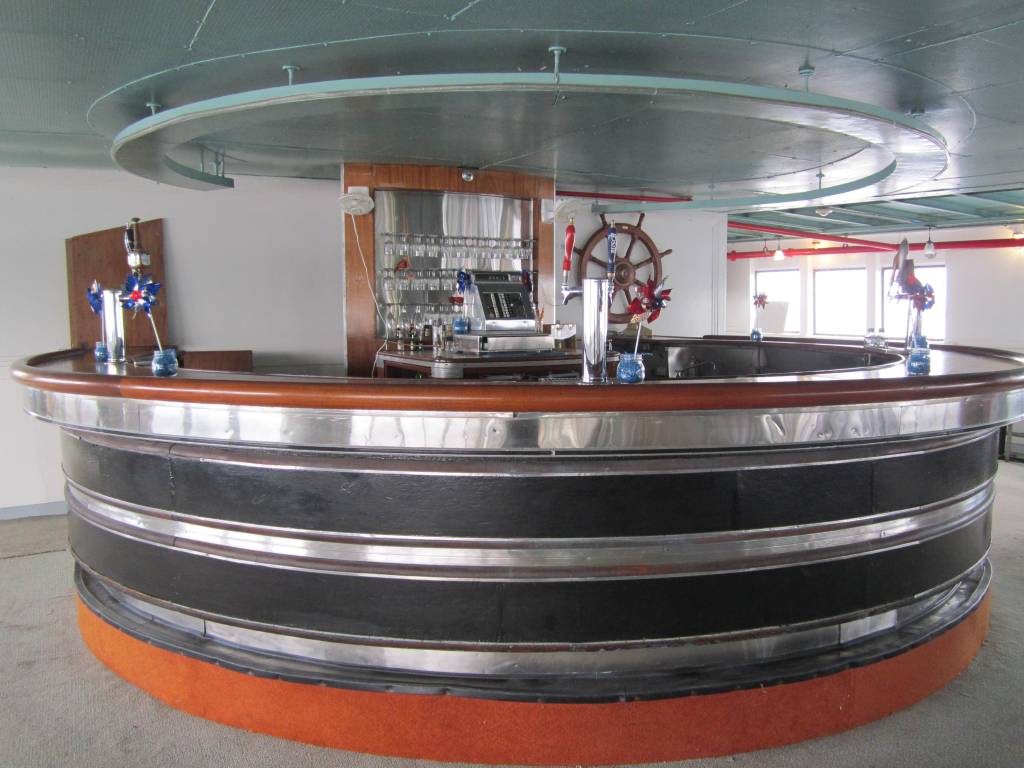
The curved bar reflects the ship’s 1940 reconstruction in Streamline Art Moderne style. Photo by Carl Swanson
After a million-dollar rebuild (the equivalent of $17.8 million today), the Juniata steamed into Milwaukee on the afternoon of June 2, 1941, and tied up at the Wisconsin & Michigan Steamship Company dock at 601 East Erie Street.
With dignitaries assembled, 16-year-old Patricia McKee of Detroit, daughter of Max McKee, one of the line’s directors, was handed a quart bottle of Wisconsin cream to rechristen the ship, Milwaukee Clipper.
Patricia swung the cream high and then brought it down with terrific force, shattering the bottle and showering cream over the guests of honor, including Wisconsin Governor Julius Heil, Milwaukee Mayor Carl Zeidler, and the directors of the steamship line.
The Milwaukee Sentinel described the christening as “brief but impressive.” The Milwaukee Journal reported, “[The dignitaries] fished out handkerchiefs and wiped off the drops and looked good-natured about it.”
The streamlined Clipper with its cream-speckled guests of honor then glided up the Milwaukee River, pausing at the Wisconsin Avenue bridge for a second rechristening ceremony, and on as far as State Street, cheered by thousands of onlookers lining the river.
The Clipper had arrived, and it would remain a local favorite for three decades.
But where did its name come from? According to the book The S.S. Milwaukee Clipper: An Illustrated History (2014, S.S. Milwaukee Clipper Preservation Inc.), Mark McKee, one of the line’s directors, was friends with the then-president of Pan American Airways and served on the airline’s board. At the time, Pan American operated a famous fleet of long-distance passenger seaplanes each named after a city the airline served followed by the word “Clipper.”
That evening the Milwaukee Clipper hosted 900 guests for a two-hour cruise on Lake Michigan. “The guests promenaded around on the decks, admiring the new chromium and stainless steel and fresh paint,” reported the Journal, which also printed the ship’s statistics: 361 feet long, 45 feet wide, a draft of 15½ feet, and a crew of 110.
“At midnight the Clipper left for her first lake crossing to Muskegon, Mich.,” the Journal added, “where she arrived Tuesday within five minutes of the crossing schedule of 5 hours and 15 minutes, an hour less than the previous schedules.”
Carrying an average of 900 passengers per trip with space for more than 100 automobiles, the new ship featured 36 staterooms and a “Pullman” section, which seated 112 passengers by day and converted into sleeping berths for 56 passengers at night.
The passengers enjoyed many amenities, including a 185-seat buffet restaurant and a bar with a 25 x 40-foot polished wood dance floor and a live orchestra. The ship also had a broad sun deck lined with chaise lounges, a 144-seat movie theatre, and a supervised children’s playroom.
But one form of passenger entertainment attracted the ire of authorities just weeks after the new liner entered service.
In July 1941, Morton Wolf, prosecuting attorney of Muskegon County, Michigan, booked a round trip aboard the passenger liner. Since his election the previous January, Wolfe had focused on ending commercial gambling – and he certainly got an eyeful of it during his voyage, including witnessing unsupervised children feeding coins into slot machines in the ship’s onboard casino.
As soon as the ship docked in Muskegon at the end of its overnight run, Wolf hurried to the office of the local justice of the peace. He had to move quickly for the Clipper spent just 30 minutes in port. Wolf returned with a platoon of law enforcement officers and a search warrant. He planned to serve the captain the warrant and seize the slot machines.
There was just one problem. The captain was missing.
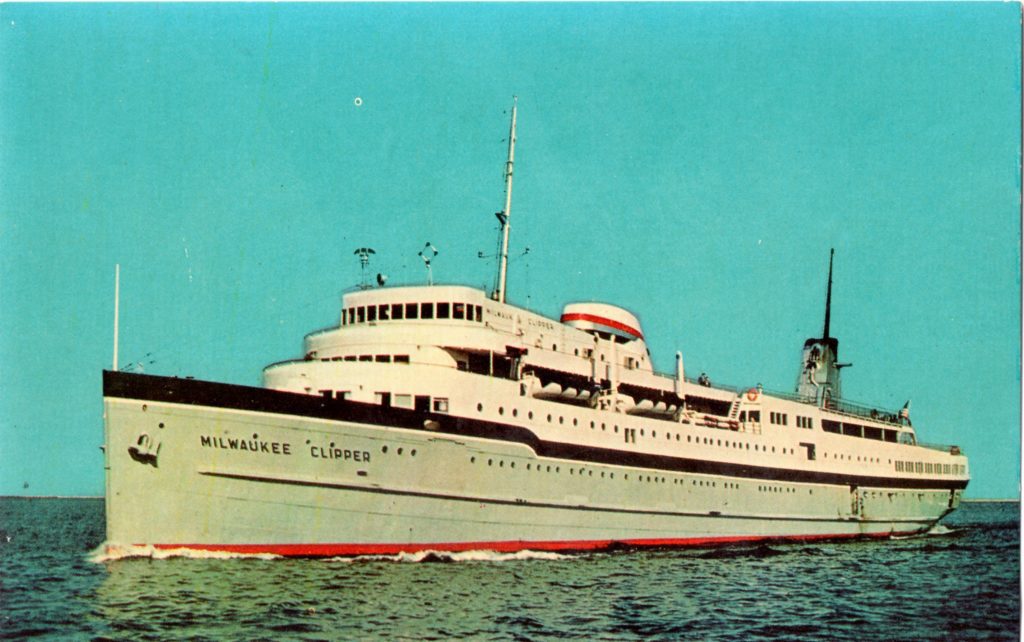
Much thought went into the ship’s appearance, including the installation of a sleek, modern-looking false funnel just behind the bridge. The ship’s actual funnel is the angular tower at the rear. Carl Swanson collection
On seeing the police officers march up the gangplank, Allen K. Hoxie, a Great Lakes’ captain since 1909, had quietly slipped away from the bridge, changed into civilian clothing, and joined the passengers.
As police milled about and Wolf searched for the captain, time was ticking away. On the bridge, the ship’s first officer patiently waited a half-hour past the appointed sailing time before sounded the whistle signaling the boat’s departure.
Wolf directed two officers, Sgt. Earl Secrist of the Michigan State Police and Muskegon County Deputy Sheriff Ralph R. Hodges, to remain and watch the slot machines then hurried ashore with the rest of his team seconds before the gangplank lifted and the Clipper steamed away to Milwaukee.
“While Wolfe sat with his warrants in Muskegon, Sgt. Secrist and Deputy Hodges were having plenty of trouble on the luxury boat,” reported the Milwaukee Journal in a page one story on July 24, 1941. “As the vessel crossed the Michigan-Wisconsin border – the middle of the lake – busboys in the employ of the Clipper line walked into the casino and began moving the slot machines.
“Not a word was said. Secrist made no protest because he knew that, having left Michigan, he had lost jurisdiction. So he and Hodges sat there helplessly watching the evacuation of their evidence. In view of hundreds of passengers sunning themselves on the deck, the busboys wheeled the machines to the rear hold.”
During the boat’s five-hour crossing, Wolf was burning up the long-distance telephone wires to Milwaukee. As soon as the Clipper docked, Milwaukee Police Detective Sgt. Martin Fallon and Detectives Al Verbel and John Zilavy stepped aboard. Hoxie was again making himself scarce, but the detectives eventually tracked the captain down then started searching for the gambling devices.
While the police officers were walking the ship’s long decks in search of the elusive Captain Hoxie, a truck backed up to the Clipper’s rear cargo door and was swiftly loaded with slot machines and driven away.
It was neatly done but the Milwaukee police were not fooled – an additional two detectives had been posted on the dock to watch for just such an attempt. The machines were seized and one man, described as the custodian of the gambling devices, was arrested.
The Milwaukee Sentinel summed it up, “When the storm cleared, the streamlined vessel had been stripped of a dozen slot machines, Milwaukee police had all the evidence and one prisoner, and the Michigan authorities who started it all had only a sheaf of unserved documents.”
Proving there were no hard feelings, the steamship line hosted Sgt. Secrist and Deputy Hodges as guests of the line for the duration of their ride from Michigan to Wisconsin and back.
“In addition to their fare they had a fine breakfast and lunch, with the company’s compliments,” wrote the Journal. “On the trip back, when there were no slot machines to look at, they had such games as shuffleboard available to them and an orchestra played a matinee concert.”
The two-state gambling raid received a moment of national attention. According to the book The S.S. Milwaukee Clipper: An Illustrated History, “ABC radio’s national news ran a story about the Clipper that sailed without its skipper.”
The space occupied by the ship’s casino was leased to a Chicago firm, Stein Amusement Co., which owned the devices. Steamship line officials claimed they had no idea games of chance were offered. Even so, they said, it was entirely legal because the machines were kept covered in port and gambling took place “outside the three-mile limit.”
The Milwaukee Journal quoted an opinion written by Milwaukee District Attorney Herbert J. Steffes saying the three-mile limit concept did not apply to the boundaries of state jurisdictions.
“Steffes cited the Wisconsin constitution to show that the eastern boundary of Wisconsin extends to the center of Lake Michigan,” the Journal reported, “and he cited Wisconsin statutes to show that the eastern boundary of Milwaukee county likewise extends to the center of the lake.”
Charges were filed in both states against company officials but were soon dropped or dismissed. The steamship line abandoned on-board gambling and the former casino became The Soda Bowl, a 35-seat snack shop selling souvenirs, magazines, light lunches, and ice cream.
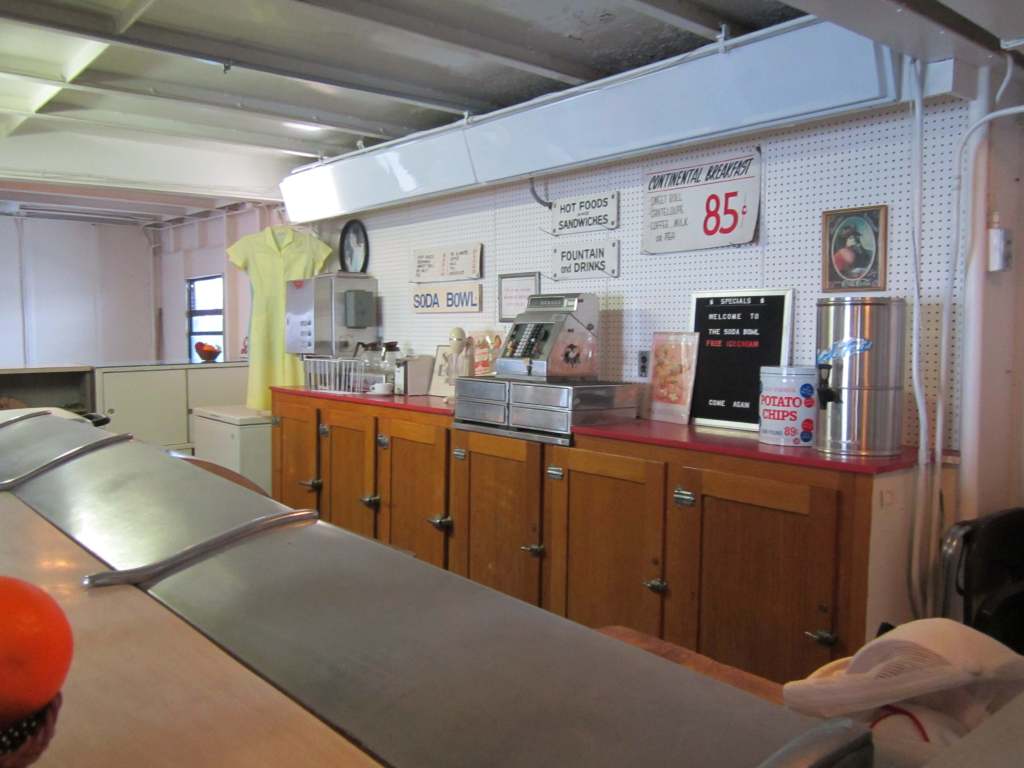
The Soda Bowl offered light meals and snacks. The room originally housed the ship’s short-lived casino. Photo by Carl Swanson
Summer after summer the Clipper steamed between Muskegon and Milwaukee occasionally adding side trips to Chicago. The ship remained popular, so much so that its owners decided to double capacity on the route by buying a former World War II troopship and spending $8 million to rebuild it into a modern passenger liner called the Aquarama.
An April 11, 2011 article in the Muskegon Chronicle described the 520-foot Aquarama. It could carry 2,500 passengers and 160 automobiles. It had five bars, four restaurants, two dance floors, a soda fountain, a solarium, a movie theater, a television room, and a children’s playroom.
“The first new passenger ship to sail the Great Lakes in more than 20 years,” the Chronicle reported, “she was heir-apparent to the aging Milwaukee Clipper on Lake Michigan’s premier cross-lake ferry route.
At the end of the 1962 season, the line announced, the Clipper would retire and the much larger and faster Aquarama would take over the route. The Milwaukee Board of Harbor Commissioners were on board with the plan and requested Milwaukee’s 1963 budget include a $700,000 dredging project to accommodate the Aquarama.
“[But] Milwaukee officials squandered the Aquarama’s rightful inheritance when they balked at dredging their city’s harbor to accommodate the ship’s deep draft,” the Chronicle added.
With the dredging proposal languishing in Milwaukee, the Clipper was suddenly back in business. After a hasty $50,000 in repairs, it returned to service in 1963. But its days were numbered. In need of extensive repairs and with tight new Coast Guard regulations on the horizon, the Clipper made its last trip on September 8, 1970, and then laid up in Muskegon.
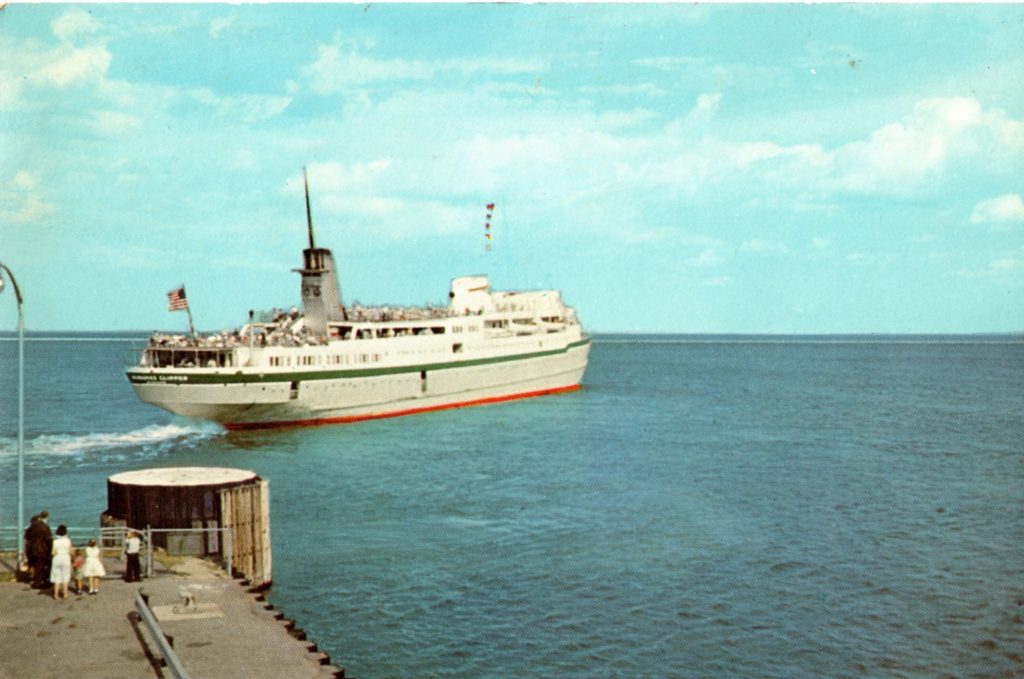
The Clipper departs Milwaukee’s Municipal Pier for another 65-mile journey to Muskegon, Michigan. Carl Swanson collection
In 1977, she was sold and towed to Sturgeon Bay, Wisconsin for repairs and a planned return to excursion service. The idea collapsed when the Coast Guard refused to certify the vessel for passenger service. A new owner renamed it S.S. Clipper and moved it to Chicago’s Navy Pier where it served as a floating – but stationary – restaurant and nightclub. A stint as a marina clubhouse in Hammond, Indiana followed. All the while the once-grand ship steadily deteriorated.
A happier event took place in 1983 when the Clipper was added to the National Register of Historic Places. The designation stated, “Many of the design elements introduced in Milwaukee Clipper are still being included in modern ocean-going passenger ships. The quadruple-expansion steam engines installed in 1905, though, are exceedingly rare, particularly in such fine condition.” She was designated a National Historic Landmark in 1989.
In 1996, the marina offered the ship for sale. A handful of fans of the old Clipper formed a non-profit organization and succeeded in purchasing the ship in 1997 and having it towed across the lake to its old home port of Muskegon. Appropriately, given the Clipper‘s brief history of hosting commercial gaming, the $45,000 cost of the tow was donated by Empress casinos.
The Clipper was back home after a 20-year absence and volunteers began the overwhelming task of restoring the long-neglected ship on a shoestring budget.
Its original sister ships are long gone. The Tionesta was sold for scrap in Hamilton, Ontario, in 1940. The Octorara was converted into a troop transport, served in the Pacific Ocean in World War II, and was scrapped in 1951 in San Francisco.
In 2007, the Aquarama, once seen as the modern replacement for the elderly Clipper, was towed all the way to Aliaga, Turkey, where it was scrapped.
The S.S. Milwaukee Clipper is six stories tall, longer than a football field, and is the oldest passenger steamer on the Great Lakes (and is six years older than the Titanic). It is open for tours in the summer months.
Improbably, incredibly, the Clipper survives.
Carl Swanson is the author of the book Lost Milwaukee from The History Press, available from book stores or online.
Lost Milwaukee
-
When Police Handed Out Courtesy Cards
 Jul 14th, 2020 by Carl Swanson
Jul 14th, 2020 by Carl Swanson
-
Riverwest Had World’s Largest Color Printing Press
 Jun 11th, 2020 by Carl Swanson
Jun 11th, 2020 by Carl Swanson
-
The Mighty Grand Avenue Viaduct
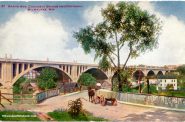 Apr 29th, 2020 by Carl Swanson
Apr 29th, 2020 by Carl Swanson


